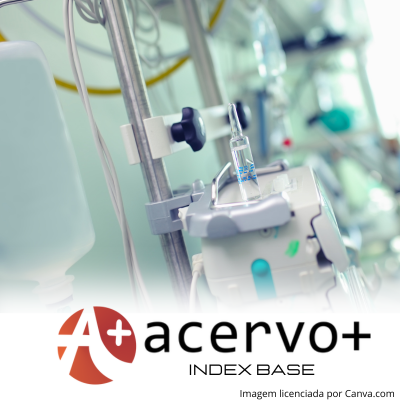Aplicação de ferramentas de gatilho para identificar reações adversas a medicamentos na Unidade de Terapia Intensiva
##plugins.themes.bootstrap3.article.main##
Resumo
Objetivo: Identificar as ferramentas de rastreio utilizadas na literatura para reações adversas a medicamentos (RAM) em pacientes em cuidados intensivos e as evidências que apoiam o uso rotineiro desses rastreadores. Métodos: Trata-se de uma revisão sistemática da literatura, baseada em estudos primários relacionados ao tema, publicados no PubMed, Scopus, Web of Science, Lilacs e EMBASE, e em periódicos mais comuns que publicam sobre segurança do paciente. Resultados: O trabalho incluiu 4 estudos primários, os resultados mostram os rastreadores como um método eficaz para identificar RAM em pacientes críticos e sugerem que um modelo ideal é aquele que inclui alertas mais eficientes para identificar um maior número de possíveis danos ao paciente, compostos por prescrição ou suspensão abrupta de determinados medicamentos, alterações em exames laboratoriais e eventos específicos durante o período de internação, e que devem ser sujeitos a modificações para adequação à prática ou cultura das instituições. Considerações finais: A escassez de estudos aponta para a necessidade de mais pesquisas nesta área para que o uso dessas ferramentas seja melhor compreendido e reproduzido.
##plugins.themes.bootstrap3.article.details##
Copyright © | Todos os direitos reservados.
A revista detém os direitos autorais exclusivos de publicação deste artigo nos termos da lei 9610/98.
Reprodução parcial
É livre o uso de partes do texto, figuras e questionário do artigo, sendo obrigatória a citação dos autores e revista.
Reprodução total
É expressamente proibida, devendo ser autorizada pela revista.
Referências
2. BRENNER S, et al. Signal and noise: applying a laboratory trigger tool to identify adverse drug events among primary care patients. BMJ Quality & Safety. 2012; 21(8): 670–5.
3. BUCKLEY MS, et al. Trigger alerts associated with laboratory abnormalities on identifying potentially preventable adverse drug events in the intensive care unit and general ward. Therapeutic Advances in Drug Safety. 2018; 9(4): 207-217.
4. COLEMAN JJ e PONTEFRACT SK. Adverse drug reactions. Clin Med (Lond). 2016; 16(5): 481-485.
5. DIPOTO JP, et al. Evaluation of an Automated Surveillance System Using Trigger Alerts to Prevent Adverse Drug Events in the Intensive Care Unit and General Ward. Drug Safety. 2015; 38(3): 311–7.
6. GRIFFIN FA e RESAR RK. IHI Global Trigger Tool for Measuring Adverse Events (Second Edition). IHI Innovation Series white paper. Cambridge, Massachusetts: Institute for Healthcare Improvement; 2009. Disponível em: www.IHI.org. Acessado em: 25 de janeiro de 2022.
7. HIBBERT PD, et al. The application of the Global Trigger Tool: a systematic review. International Journal for Quality in Health Care. 2016.
8. HOUGLAND P, et al. Performance of International Classification of Diseases, 9th Revision, Clinical Modification Codes as an Adverse Drug Event Surveillance System. Medical Care [Internet]. 2006; 44(7): 629–36. Disponível em: https ://www.jstor.org/stable/40221330. Acessado em: 2 de julho de 2023.
9. JBI. JBI Manual for Evidence Synthesis. Aromataris E, Munn Z, editors. JBI; 2020.
10. KANE-GILL SL, et al. Use of Text Searching for Trigger Words in Medical Records to Identify Adverse Drug Reactions within an Intensive Care Unit Discharge Summary. Appl Clin Inform. 2016; 7(3): 660-71.
11. KHAN LM, et al. Detection of adverse drug reactions by medication antidote signals and comparison of their sensitivity with common methods of ADR detection. Saudi Pharmaceutical Journal. 2015; 23(5): 515–22.
12. LOPEZ-GONZALEZ E, et al. Determinants of under-reporting of adverse drug reactions: a systematic review. Drug Saf. 2009; 32(1): 19-31.
13. MARTINS RR, et al. Trigger tools are as effective as non-targeted chart review for adverse drug event detection in intensive care units. Saudi Pharmaceutical Journal [Internet]. 2018 Dec [cited 2020 Jan 30];26(8):1155–61. Disponível em: https ://www.sciencedirect.com/science/article/pii/ S1319016418301427. Acessado em: 25 de janeiro de 2022.
14. MOLINA FJ, et al. Adverse events in critical care: Search and active detection through the Trigger Tool. World Journal of Critical Care Medicine. 2018; 7(1): 9–15.
15. MUNN Z, et al. Methodological guidance for systematic reviews of observational epidemiological studies reporting prevalence and cumulative incidence data. International Journal of Evidence-Based Healthcare. 2015 Sep; 13(3): 147–53.
16. NEBEKER J, et al. Considering sensitivity and positive predictive value in comparing the performance of triggers systems for iatrogenic adverse events. Abstract presented at the Agency for Healthcare Research and Quality Annual Conference. Bethesda, MD, September 2009.
17. PIERDEVARA L, et al. An experience with the Global Trigger Tool for the study of adverse events in a medical ward. Revista de Enfermagem Referência. IV Série. 2016; 97-106.
18. PIERDEVARA L, et al. Trigger Tool na Segurança do Doente: Uma Revisão Sistemática de Literatura. Portuguese Journal of Public Health, 2017; 35(2): 69–76.
19. RATZ Y, et al. The Importance of the Pharmacist in Reporting Adverse Drug Reactions in the Emergency Department. The Journal of Clinical Pharmacology. 2010; 50(10): 1217–21.
20. SHAMSEER L, et al. Preferred reporting items for systematic review and meta-analysis protocols (PRISMA-P) 2015: elaboration and explanation. BMJ [Internet]. 201; 349(1): 7647–7. Disponível em: https ://www.bmj.com/content/349/bmj.g7647. Acessado em: 25 de janeiro de 2022.
21. SHEIKH A, et al. The third global patient safety challenge: tackling medication-related harm. Bulletin of the World Health Organization [Internet]. 2017 Aug 1;95(8):546–6A. Disponível em: https ://www.ncbi.nlm.nih.gov/pmc/articles/PMC5537758/. Acessado em: 25 de janeiro de 2022.
22. TUFANARU C, et al. Chapter 3: Systematic Reviews of Effectiveness. JBI Manual for Evidence Synthesis. 2020.
23. WELLS G, et al. The Newcastle-Ottawa Scale (NOS) for assessing the quality if nonrandomized studies in meta-analyses. Ottawa Hospital Research Institute [Internet]. www.ohri.ca. 2021. Disponível em: https ://www.ohri.ca/programs/clinical_epidemiology/oxford.asp. Acessado em: 7 de março de 2022.
24. ZAUGG H, et al. Mendeley: Creating communities of scholarly inquiry through research collaboration. TechTrends, 2011; 55(1): p.32-36.

